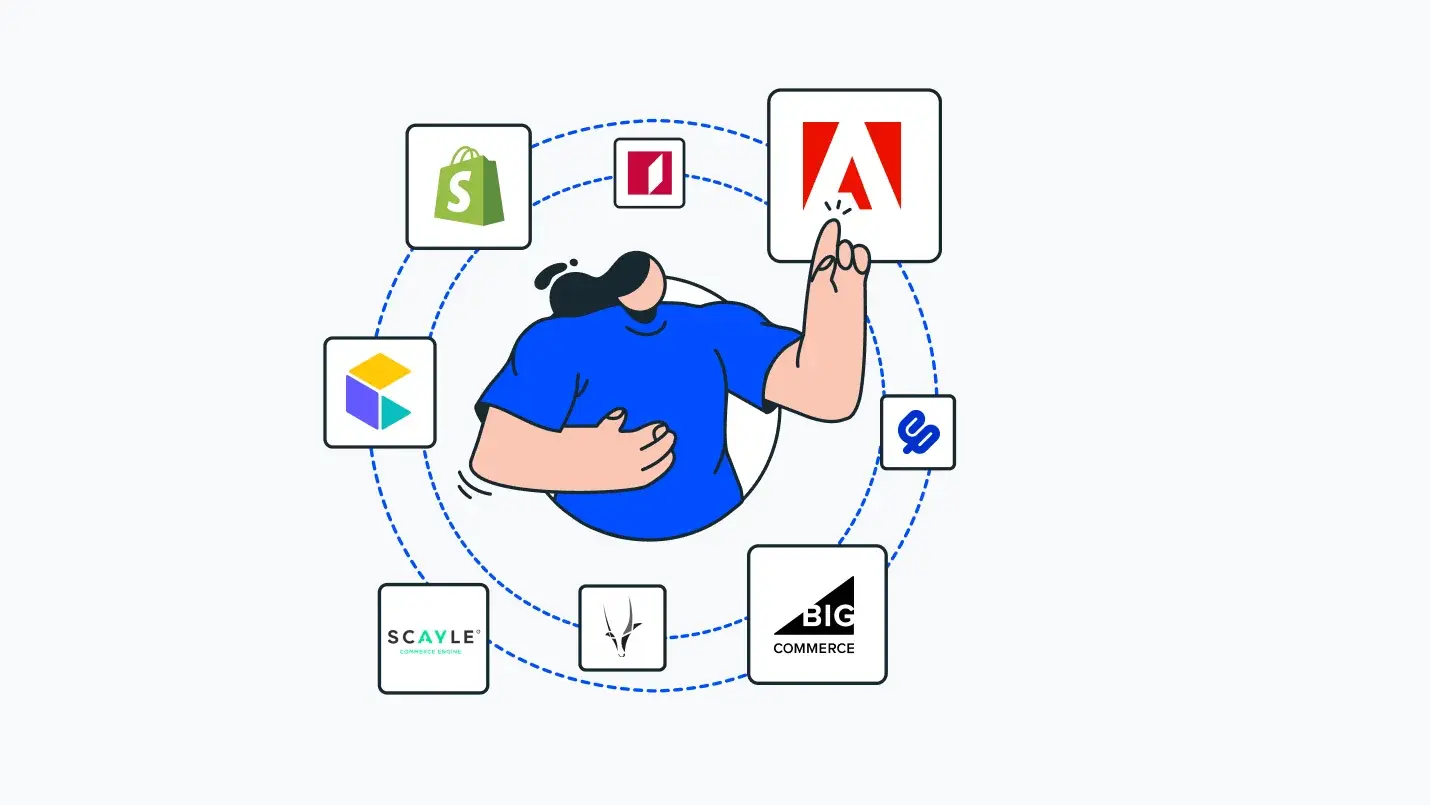Nearly two-thirds of B2C and B2B businesses today are planning a shift to headless commerce platforms to unlock increased agility, scalability, and innovation and to enable more personalized omnichannel support, according to research from Market Digits and BigCommerce. Given the growing interest, there are a wide variety of headless commerce platforms available today, making it harder than ever to decide what is right for you.
Having partnered closely with retailers and B2B leaders for over a decade on commerce solutions, and as leaders in eCommerce development, we have compiled a list of the platforms we recommend the most often. These platforms are ones we’ve worked with, we’ve seen results from, and that our clients are happy with.
We will review each platform in depth, pull out what you need to know, and share some of the pros and cons for each choice. If you instead want expert insight into what’s right for you, we’re happy to help.
What Are Headless Commerce Platforms?
Headless commerce platforms are designed so that the head (the front-ends, what you know as your storefront) are separated or decoupled from the functional back-end of your store. Headless commerce platforms are designed to allow you greater technical agility, allowing you greater flexibility to adjust your tech stack and to create custom front-end experiences for different channels or devices.
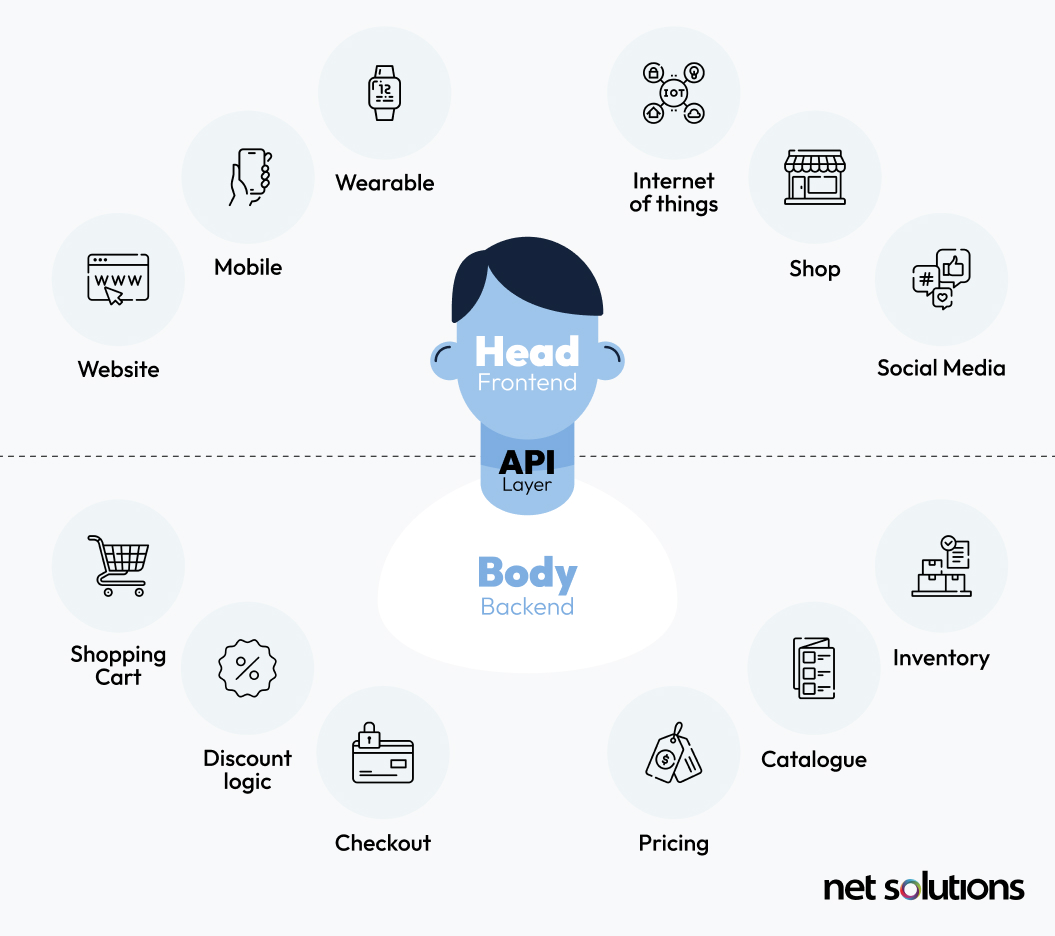
Headless commerce is differentiated from traditional commerce, which tightly couples the front-end and back-end into one codebase, and from composable commerce, which further breaks down the front and back-ends into components that can be worked on, swapped out, or scale independent of the rest of the system.
Let’s have a look at why you might want to consider headless eCommerce platforms.
What Are the Benefits of Headless eCommerce Platforms?
While there are many very individual factors that go into choosing the architecture of a platform and a specific platform, all of which are dependent on your own business and needs, in general, some of the benefits of headless commerce include:
- Flexibility: Flexibility includes the ability to customize the tech stack with different frameworks and languages to create optimal designs and user experiences without being tied to the backend.
- Customizable: With greater tech stack agility, it is easier to spin out new front-ends as needs evolve and many headless platforms specifically lean into flexibility by making it easy to customize the backend by using APIs.
- Scalability: The system can scale vertically (in response to traffic), with scaling of each channel independent of the others. Further, headless platforms support horizontal scaling, making it easier to expand to new channels.
- Faster time-to-market: Headless commerce platforms are API-first, meaning they are designed to easily integrate with new services or features, allowing you to push new capabilities out to all channels. Further, front-end teams can work independent of back-end teams for greater efficiency.
- Omnichannel experience: As the talk of channels implies, the ability to deliver an omnichannel experience is one of the top benefits of headless. This capability reflects the desire by customers to interact with stores across channels and have a consistent experience, made possible by having one backend (catalog, inventory, customer data).
- Enhanced integration: Headless platforms are designed to interface with your systems of record (CRM, CMS, ERP), new front-ends, and third-party services making it easier to include new innovations.
- Performance: Leaner frontends and content reuse across channels contribute to optimized performance.
If you are a B2B business, or have a B2B model as part of your overall business, the benefits of headless commerce for B2B are similar, although the specific features you will be looking for from your headless platform will likely be different.
In the following list, we’ll share what we consider the 10 best headless commerce platforms, including any features that may be relevant for B2B businesses as well.
The 10 Best Headless Commerce Platforms
The following represent the headless commerce platforms that have been successful for our clients, which offer a combination of features, performance, and innovation, and which are often recognized as leaders or major players by analysts such as IDC, Gartner and Forrester. For each platform, we’ll identify top features, pros and cons, pricing, and some reviews from real users as displayed on the review platform G2.
1. Shopify Plus
Shopify Plus is an enterprise commerce platform began as a traditional platform, now available to be deployed with Shopify’s React-based headless stack or on the stack of your choosing. Shopify is designed to support complex global businesses with strong workflow automation capabilities and a history of innovation, with over 100 product updates every six months.
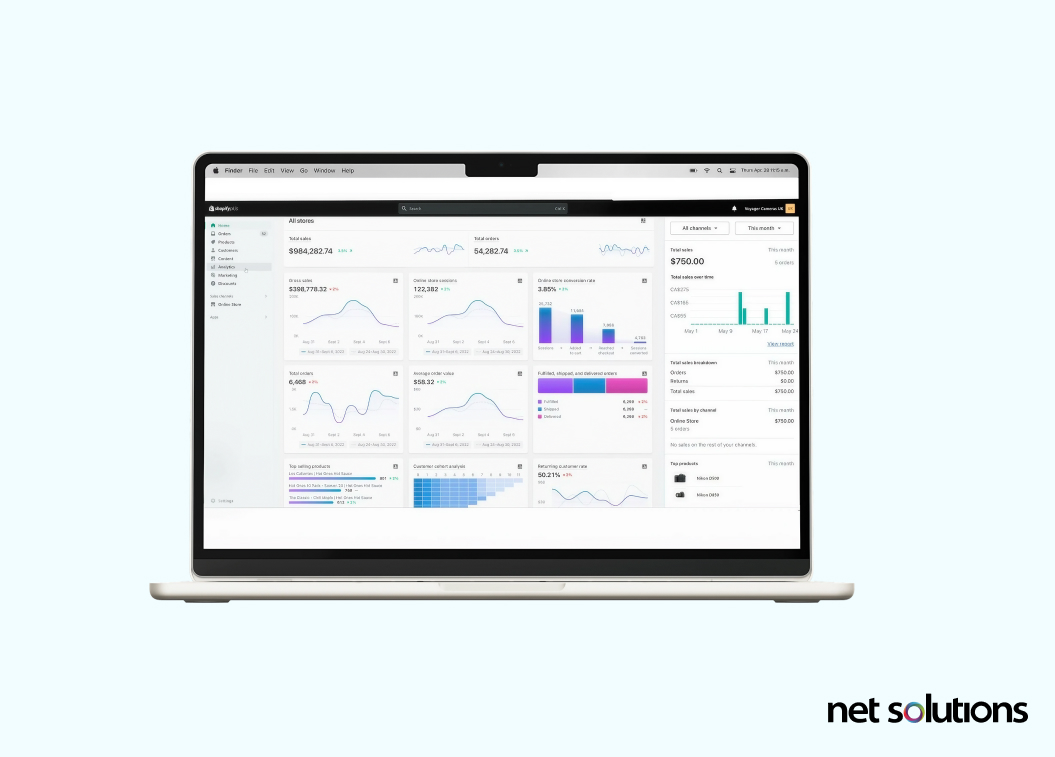
“Switching to Shopify Plus has been one of the best decisions for our business. As we grew, we needed a platform that could keep up with our increasing demands, and Shopify Plus has exceeded our expectations. The scalability of the platform has allowed us to handle high volumes of traffic, especially during peak sales periods, without any hiccups. The advanced customization options have been invaluable, enabling us to create a unique shopping experience that resonates with our brand and customers.” – Joseph F.
Top features:
- High-speed performance: Global dual content delivery networks (CDNs) and optimizations, average 99.99% uptime
- Integrated AR, video and 3D: Advanced capabilities on product catalogs & pages
- Extensible: Integrate with Shopify Plus Partners or Certified Apps to extend site features, capabilities or sales channels with a lower development cost
- Automation: Automate tasks and build custom workflow solutions across all your stores and existing apps
- Unlimited SKUs: Support for unlimited SKUs, a huge pro for global brands
- Strong B2B features: Out-of-the-box B2B capabilities for curated catalogs, custom pricing, personalized storefronts, and self-serve portal.
Integrations:
Integrate with your systems of record or with Shopify Plus Certified Apps and Partners such as Klaviyo, Mialchimp, Gorgias, and Loox.
Pricing:
ShopifyPlus starts at $2300 per month, for a 3-year term, or custom pricing for more complex businesses. Each Shopify Plus contract is limited to one brand, but can support up to 20 locations and 9 storefronts. Additional storefronts are subject to fees or revenue sharing agreements.
Lower-priced Shopify plans are not headless.
Target market:
Shopify Plus is an enterprise commerce platform for high-growth businesses, aimed at those with revenue between $1M and $500M.
Pros:
- Comprehensive platform that includes automation and customization without third-party services
- Offers a self-host option or a strong (free) headless hosting option
- Highly customizable checkout with strong history of conversion
Cons:
- Each brand must have its own contract, so becomes costly and complex for some organizations
- AI is more focused on workflow rather than personalization
- Some basic features require third-party apps, increasing an already steep cost
2. BigCommerce
BigCommerce is a headless and composable platform to make enterprise commerce easier to manage, with advanced capabilities and innovations across AI, and the scalability you need to manage multiple brands, storefronts, locations, and more.
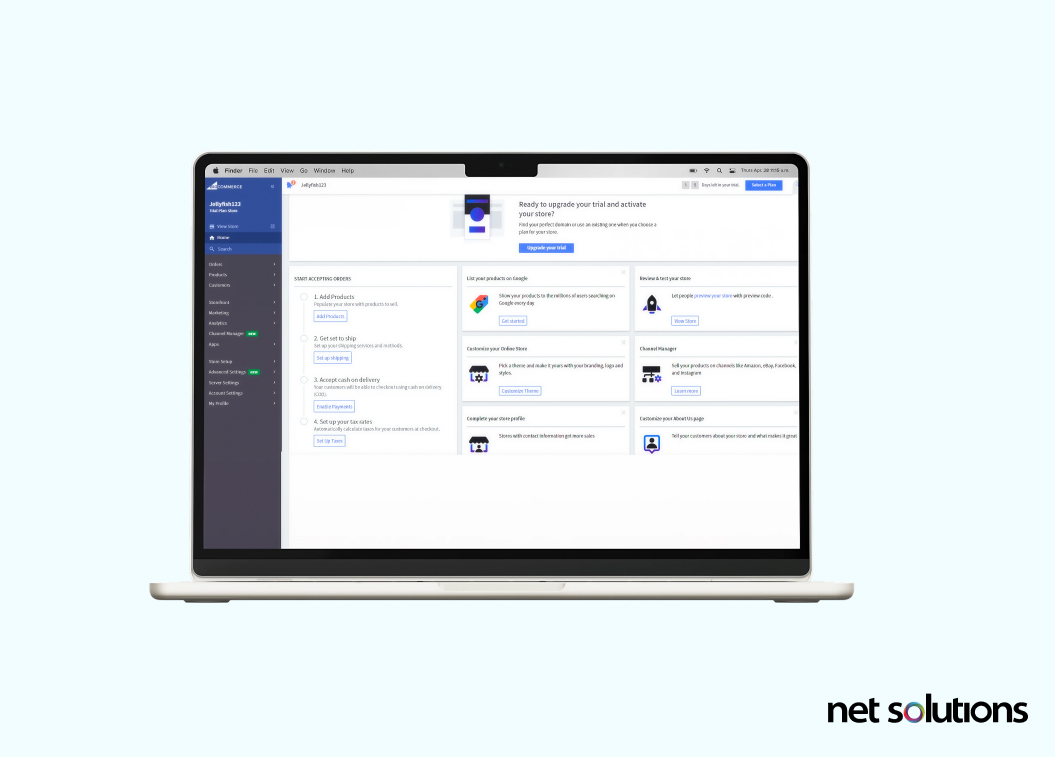
“Ease of use aside, BigCommerce has been an invaluable part of our growth. Its integration capabilities have been deployed seamlessly across a myriad of apps including Klaviyo, Search Spring and a multitude of other automation tools employed across the site which has been crucial in our being a low cost model. The platform’s open API enables easy customisation allowing us a much clearer insight into customer behaviour and internal business performance. Several features of BigCommerce have directly contributed to our business growth. The platform’s scalability, with its ability to handle high-volume transactions without sacrificing speed or performance, has been a game-changer as our business has expanded. Its inbuilt SEO tools and mobile optimization features have significantly improved our online visibility and search rankings. Plus, with BigCommerce’s advanced product management features and automation capabilities, we’ve been able to manage inventory and orders efficiently, helping us scale without increasing our team size and increasing costs.” – Deepak K.
Top features:
- Strong editor tools: Page builder visual tool, drag-and-drop merchandising and integrated preview, native CMS
- Innovative AI: the enterprise plan features new AI capabilities for product recommendations, predictive analytics, semantic search, SEO product descriptions and metadata
- UI kit Catalyst: Newly designed to accelerate front-end development
- Conversion tools: Create coupons, discounts, support custom product recommendations, and include faceted search
- B2B capabilities: Bulk ordering, quoting, custom catalogs and prices, wholesale tools, open-source buyer portal, and B2B quote assistance (enterprise)
Integrations:
BigCommerce has a strong ecosystem of integrations including Stripe, Klaviyo, PayPal, Acumatica and Bloomreach.
Pricing:
BigCommerce has four pricing plans, Basic, Plus, Pro, and Enterprise. The switch between plans is automatic, but there are no hidden costs, fees, or bandwidth overages.
- Basic (Sales up to $50k per year) – $39 / month if paid monthly
- Plus (Sales up to $180k per year) – $105 / month if paid monthly
- Pro (Sales up to $400k per year) – $399 / month if paid monthly
- Enterprise – Starting at $1000+ / month if paid monthly
Target market:
BigCommerce is targeted for mid-to-large enterprises or small to large B2B businesses, where the concept of ‘large’ enterprises begins at $400k per year.
Pros:
- Multi-everything, offering multi-storefront capabilities to support regions, segments, brands or channels (e.g. marketplaces) from a single dashboard
- Composable, offering greater levels of customization and agility for both the front and back-end
- Low enterprise starting cost
Cons:
- Not suitable for the largest enterprises
- Limited base features, so sometimes features can be outside your price tier
- B2B is a separate edition, not an integrated part of the core platform
3. Adobe Commerce (Magento)
Adobe Commerce is a leading enterprise solution delivering fast, personalized commerce experiences in a platform that can be deployed as a traditional solution or as a headless and composable solution. Adobe Commerce is an enterprise leader, offering a free open-source version as well as a much more comprehensive and scalable hosted solution for high-growth enterprises.
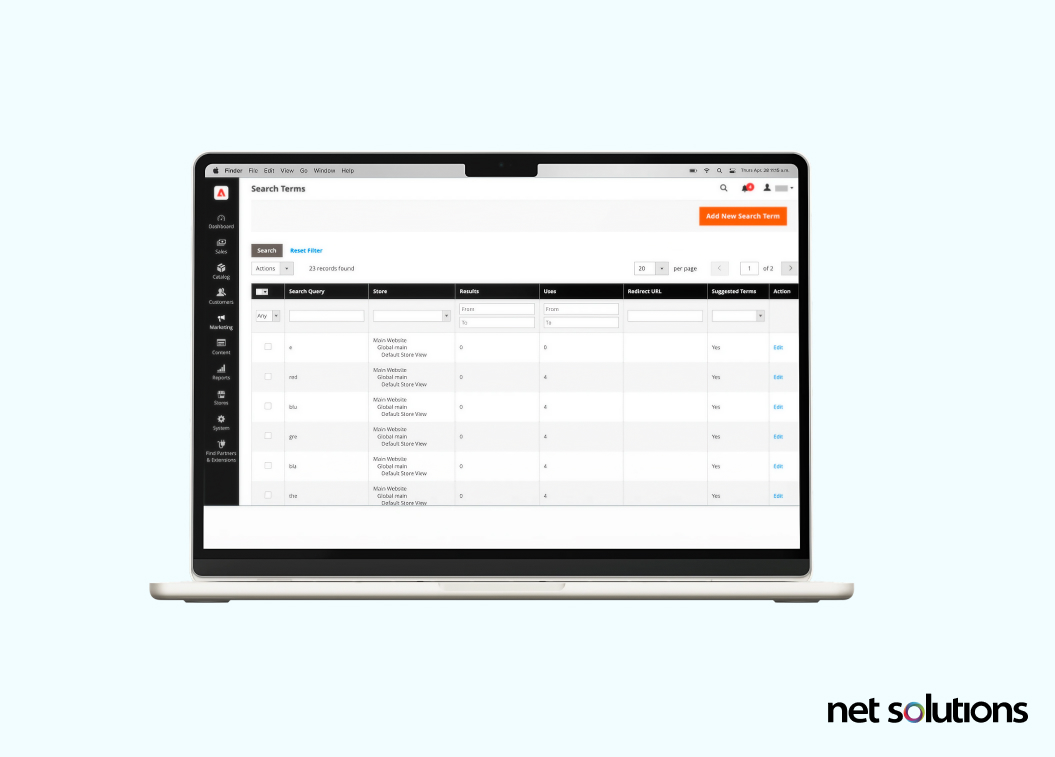
“The Adobe Experience Cloud is something I like the most because it just brings everything together. By integrating marketing, analytics, and content management tools seamlessly, this makes it very effective and user-friendly. I love that it goes deep into customer habits so that I can create my own customized marketing campaigns. This is a game-changer in terms of real-time data analytics and automation functions which help me to make better decisions about my marketing efforts.” – Arvind M.
Top features:
- Adobe Sensei GenAI: is built-in to the on cloud platform, offering genAI for workflows, personalized experiences, search, and analytical insights
- Merchandising tools: built-in order and inventory management capabilities right from the dashboard supported by new AI-driven merchandising tools
- App Builder: an extensibility platform for integrating and creating custom experiences to extend Commerce functionality
- Page Builder: create and launch compelling content with drag-and-drop capabilities and personalized experiences
- Native B2B capabilities: The on-cloud version features advanced B2B capabilities for shared catalogs, pricing, portal, fast reordering and more
Integrations:
Integrate with third-parties using APIs or integrations such as Dominate, Klarna, Stripe, ShipStation or Microsoft 365, or take advantage of the extensive Adobe ecosystem to add the Adobe Experience Manager or Real-Time Customer Data Platform.
Pricing:
Adobe Commerce maintains the original intent of Magento through Magento Open Source (free, self-hosted) and also offers three licensed versions with more capabilities: Adobe Commerce On-Premise and the two On Cloud products with pre-integrated cloud services, Adobe Commerce Pro and Adobe Managed Services. All licensed products are custom priced, estimated at a minimum of $24K per year.
Target market:
Magento Open Source is aimed at small to medium businesses with the intention of scaling to the Adobe Commerce platform, which is aimed at large to very-large global enterprises.
Pros:
- Very extensive reporting capabilities, with over 100 best practice reports for the on cloud version
- Enterprise-grade platform, with advanced security, site management, omnichannel and localization capabilities
- Can grow with brands, from open-source to hosted On Cloud
Cons:
- The open-source version lacks the powerful capabilities of the On Cloud licensed version
- High license and development costs due to the number of technical considerations and capabilities
- Requires a high degree of technical knowledge
4. commercetools
Commercetools is the one of the first headless platforms on the market and has retained its industry-leading position in the space with its composable MACH architecture that additionally leverages a microservices model for added flexibility and agility to iterate and innovate easily. commercetools averages over 200 updates per year, a strong history of innovation.
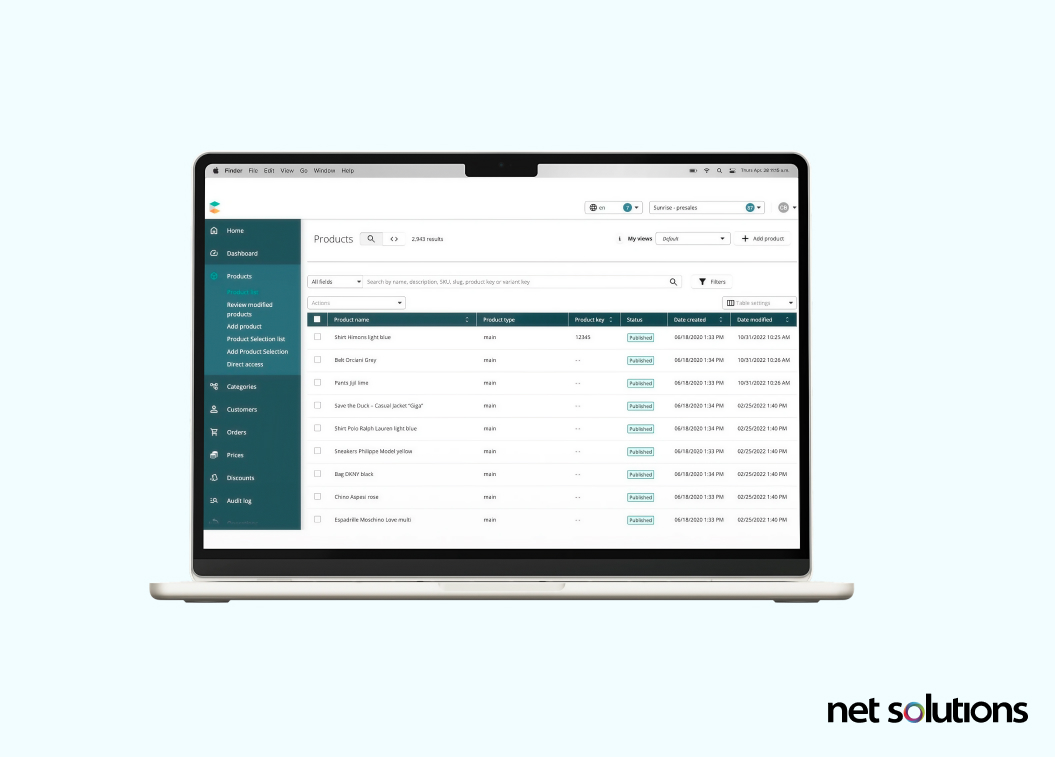
“Commercetools is a very feature-rich digital commerce platform. Its support for MACH architecture has made it highly flexible and easy to integrate with our legacy systems. Its integration with payment solutions has made it a complete platform.” – Banking user
Top features:
- commercetools Foundry: a pre-composed solution (still headless) that combines best practices, services and AI tools to launch a store quickly (B2C or B2B independently)
- commercetools Frontend, a frontend-as-a-service (FEaaS) solution to develop front-ends with PWAs or to build custom front-ends in an intuitive development environment
- commercetools Connect: an integration framework to help you integrate with systems of record or third party services
- Customizable checkout: Leveraging seamless checkout and a library of 300+ APIs, it’s easy to get the checkout experience you want
- Any kind of B2B: Designed for any kind of B2B needs, including wholesaler and marketplace, with customized catalogs and pricing, automations, approvals, and personalization
Integrations:
Commercetools has integrations with Adyen, Acquia, 7Learnings, Algolia, Coveo and more.
Pricing:
Commercetools pricing is on-demand only, scaling as you grow, estimated around $45k on average Pricing models are likely to differ, including infrastructure cost and a variable fee per order.
Target market:
Commercetools is an enterprise platform designed for the very large enterprise segment with significant technical resources.
Pros:
- Precomposed solution can drastically improve time to market
- Modular design makes it possible to choose only the components (built-in applications) you want from the platform, reducing technical bloat
- Microservices approach allows for agility to changing innovations and needs
Cons:
- Base platform may have some limitations for marketing and order management
- Limited third-party integrations and SKDs, despite being a market leading platform
- Can have a high learning curve, even for technical users, although some recent tech-agnostic developer tools are reducing this complexity
5. Elastic Path
Elastic Path is a composable headless commerce solution designed to support both B2C and B2B commerce, with strong developer tools and new no-code tools for marketers and developers. Designed to make headless solutions accessible, with no-code and price, the relatively newer platform has strong reviews.
“Elastic path is very helpful for commerce as it has a smooth and reliable API. For my business, it’s important to have the implementation of projects, web tools that I can easily get from Elastic Path and can use so easily. I employ it as I need to give my users or customers a better experience and make them satisfied.” – Md. Arafat B.
Top features:
- Studio: Rapidly launch new storefronts, sites, or shoppable landing pages with this no-code tool
- Product Experience Manager: Integrated PIM, catalog (unlimited catalogs) and pricing management service can be combined to help create dynamic bundles, flash sales, loyalty catalogs and more without development assistance
- Subscription management: Unique subscription tools help drive subscription model businesses
- Composer: Intelligent platform low and no-code tools to speed up adding or creating integrations, making changes, and proactively monitoring operations
- B2B features: catalogs, negotiated pricing, unique product assortments, role-based capabilities, quick and bulk orders, re-orders
Integrations:
Elastic Path makes it easy to integrate with third-party services including Klevu, Talon.One, Open AI, Fluent and more.
Pricing:
Elastic Path is available only at custom pricing, though it does have a free trial. There are three price tiers, the first of which only adds Product Experience Manager capabilities to an external eCommerce platform, and two which offer pre-integrated capabilities.
Target market:
Looking to target small to mid sized businesses who historically face technical or price barriers in adopting headless and composable solutions.
Pros:
- Strong low code no code tools for both editors and developers
- Personalization capabilities are easy to use and understand
- Some of the best customer service, being labeled a ‘partner’ in Gartner reviews
Cons:
- Low product maturity
- Java-based solution, which may not work for some organizations
- No built-in CMS, which is common for some of the stronger enterprise solutions
6. Salesforce Commerce Cloud
Salesforce Commerce Cloud (previously Demandware) is a unified commerce solution, part of the Salesforce Customer Success Platform. Salesforce Commerce Cloud can be deployed as a traditional or through a fully headless approach. Salesforce has been one of the leaders in developing AI for commerce.
“I love how versatile Salesforce is. It can be used in almost any industry and customized for any business. They handle large data sets fairly well, and they are mostly reliable. I love how much documentation and how many trainings and events are available for people who really want to get into the Salesforce community. There are loads of people willing to help if you need it and there are plenty of examples to see how to use the service.” – Jason S.
Top features:
- Einstein 1 AI solutions: Assistive AI experiences for both customer personalization and personal shopping advice and employee workflow using GenAI.
- Personalization: AI-driven accurate predictions and personalization that crosses channels, including social and marketplace
- Unified Commerce: The new Unified Commerce option comes with B2B and D2C support with commerce, marketing, sales and service connected on a single catalog
- Composable storefronts: a faster way to create a PWA storefront
- B2B: Available as a separate edition, includes order management, promotions, reordering, customer-specific pricing, price books, enhanced search, and AI workflow automation
Integrations:
Aside from integrating with other Salesforce systems, you can integrate with FedEx, Adyen, Elyn and Mirakl.
Pricing:
Salesforce pricing is all based upon demand, with separate plans for B2C and B2B. B2C has three plans (Starter, Growth, Plus) and B2B has two plans (Starter, Growth). Plan price is based upon gross merchandise value. Support (“Success Plans”) are add-ons. There are no pricing details for the Unified Commerce plan (B2B and B2C combined).
Target market:
Designed to support large global enterprise customers who want to take advantage of a comprehensive number of Salesforce tools.
Pros:
- Deep integration with other Salesforce tools, particularly those in the customer space, can help deliver strong results
- Strong integration tools, which is helpful as most integrations will need to be custom
- A unified commerce solution that includes CRM, channels and operational functions (inventory, orders)
Cons:
- High learning curve for developers and end-users, particularly as there are few integrations
- High cost
- B2B was previously a separate edition, rather than integrated in a single platform, but a new Unified Commerce platform has been announced (no pricing details)
7. VTEX Commerce Platform
VTEX is a headless and composable commerce (B2B and B2C) and marketplace platform built on MACH architecture, offering comprehensive “apps” to take headless to new heights for, making it one of the ‘visionary’ leaders in the headless space (according to Gartner). Despite it’s newer status, VTEX’s innovations have attracted global brands such as Coca-Cola and Walmart as its customers.
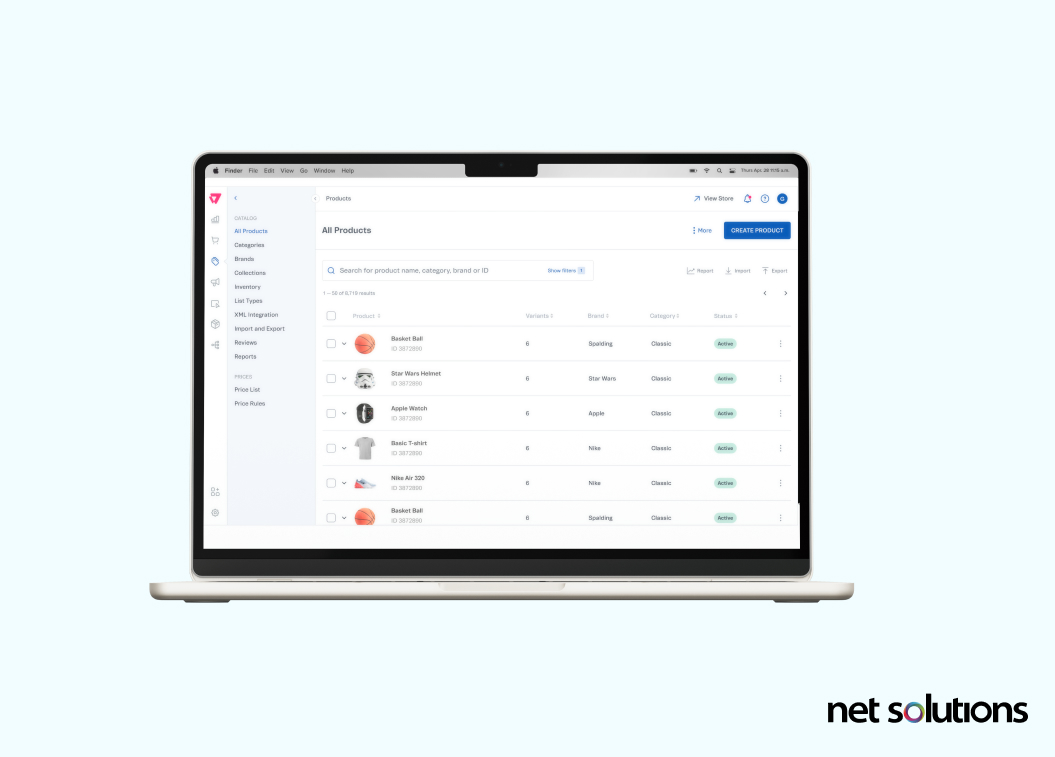
“Our overall experience with VTEX has been highly positive. The platform has significantly streamlined out operations and improved our customer relationship. The comprehensive features and robust integrations have allowed us to automate many processes, reducing manual workload and errors. The implementation process was smooth and very quick, and the support from VTEX and ITGlobers has been excellent.” – Gartner customer review
Top features:
- VTEX IO: a low code development platform of pre-built components, themes, package APIs, and developer tools to build storefronts, custom admin apps or backend integrations
- Collaborative Commerce: combines eCommerce, marketplace, order management, and a no-code CMS into a single solution
- AI tools: AI tools currently power intelligent search
- Live Shopping: Innovative tools for personalized shopping and live streaming, with integrated shopping
- B2B features: including saved card, reordering, bulk ordering, role based views, quotes, and saved cart management
Integrations:
VTEX offers integrations through an “app store”, including Hotjar, Meta Business, Iubenda, and YourViews Reviews.
Pricing:
The VTEX Commerce Platform is available at custom pricing levels that are tailored to each customer’s needs (no baseline).
Target market:
VTEX is working to attract large global brands with tools to help accelerate time to market.
Pros:
- Easy to implement, accelerating time to market
- Innovative capabilities such as Live Shopping are unique to the industry
- Extensive security capabilities for enterprise needs
Cons:
- Relatively newer and less mature platform
- Less advanced AI capabilities
- Limited app marketplace
8. Spryker
Spryker is a newer, modern headless and fully composable platform designed primarily for B2B, marketplaces, and D2C, but with limited support for B2C. Spryker can be deployed to Spryker’s cloud as either traditional or headless and has also attracted high analyst ratings and global brand support due to its innovative capabilities to support touchpoints such as mobile apps, voice assistants and IoT devices.
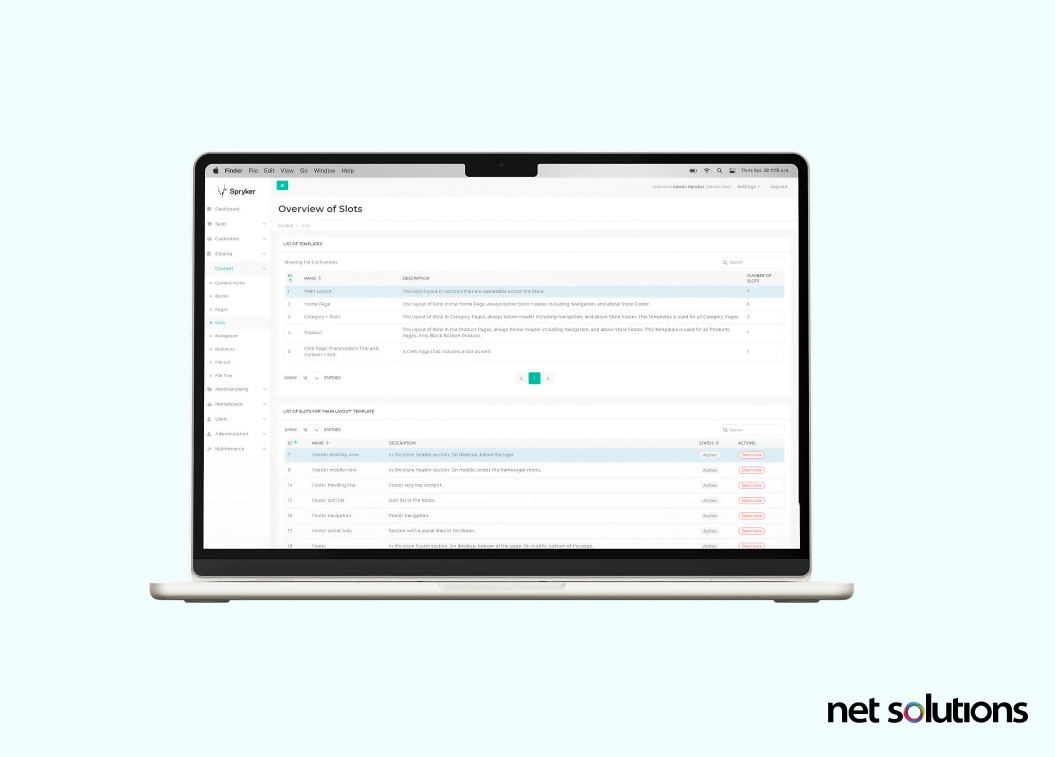
“Modular Architecture , Performance, Customizability, Decoupled Front-End and Back-End , good integrated Apis. Overall, Spryker Cloud Commerce OS provides a powerful, flexible, and developer-centric environment that enables the creation of highly customized, scalable, and efficient eCommerce solutions. The platform’s modularity, customizability, and robust performance capabilities make it an excellent choice for developers looking to build modern eCommerce systems.” – Christian M.
Top features:
- Composable Storefront: New option (early access only) of standard components and preconfigured applications to create front-ends quickly
- IoT commerce: unique capabilities to harness IoT commerce with tools designed to optimize IoT connections (e.g. voice assistant, smart shelves, NFC)
- Unified Commerce: Packaged business capabilities across CRM, PIM, CMS, order management capabilities built into the platform
- Marketplace: Create your own marketplace with enterprise capabilities to manage products, search, orders, fulfillment and more
- B2B is add-on: barcode generator, customer specific pricing and catalogs, shopping list, multiple carts per user, quotes and approvals, agent assisted buying
Pricing:
Spryker Commerce Cloud OS and the B2B Suite are available at custom prices only.
Target market:
Strong enterprise B2B and global retail focus, as well as enabling unique marketplace development.
Pros:
- Ideal for complex B2B models
- Market leader in reaching IoT channels across a wide variety of use cases (particularly in retail)
- High degree of customization due to composable platform
Cons:
- Not suited to small businesses
- While advanced in some areas, immature in areas others would find standard (personalization, AI)
- Integrations are not straightforward
9. SCAYLE
SCAYLE (SCAYLE Commerce Engine) is an enterprise composable headless commerce platform that also makes available the option to use a built-in frontend to accelerate time to market. The platform is new but growing at a rapid pace and is attracting larger clients as it does.
“SCAYLE has allowed us to scale rapidly with its powerful out-of-the-box capabilities. The flexibility and depth of its features mean we can focus on enhancing the customer journey, while SCAYLE seamlessly handles the back-end complexities. It’s a game-changer for our growth strategy.” – Niklas K.
Top features:
- Digital storefront: A built-in frontend you can use to accelerate time to market and swap out later whenever you want
- Unified capabilities: Capabilities across PIM, order management tools that are easy to scale, internationalize, and include built-in automations
- AI-Search: AI-powered search recommendations
- Promotions: Segment-based promotions with fine tune capabilities
- Subscriptions: Simple tools to manage subscriptions (add-on product)
Integrations:
SCAYLE integrations require third-party tools or custom development.
Pricing:
SCAYLE does not transparently disclose its pricing models any longer, but previously plans started at $5K per month.
Target market:
SCAYLE is targeting the mid-to-large enterprise market with headless capabilities supported by no-code tools.
Pros:
- Multi-support, including multi-brand, omnichannel, internationalization, marketplaces
- Intuitive tools to create new customer experiences, stores, markets or brands without code
- High performance statistics with the built-in frontend
Cons:
- No B2B support
- Relatively immature platform, may lack some features (advanced AI, personalization)
- No third-party marketplace of integrations
10. Intershop
Intershop is a headless and composable commerce platform designed specifically for manufacturers and wholesalers, with over 100 APIs designed to support B2B features and the option to deploy a PWA head, but with the addition of basic B2C commerce support (included in all plans).
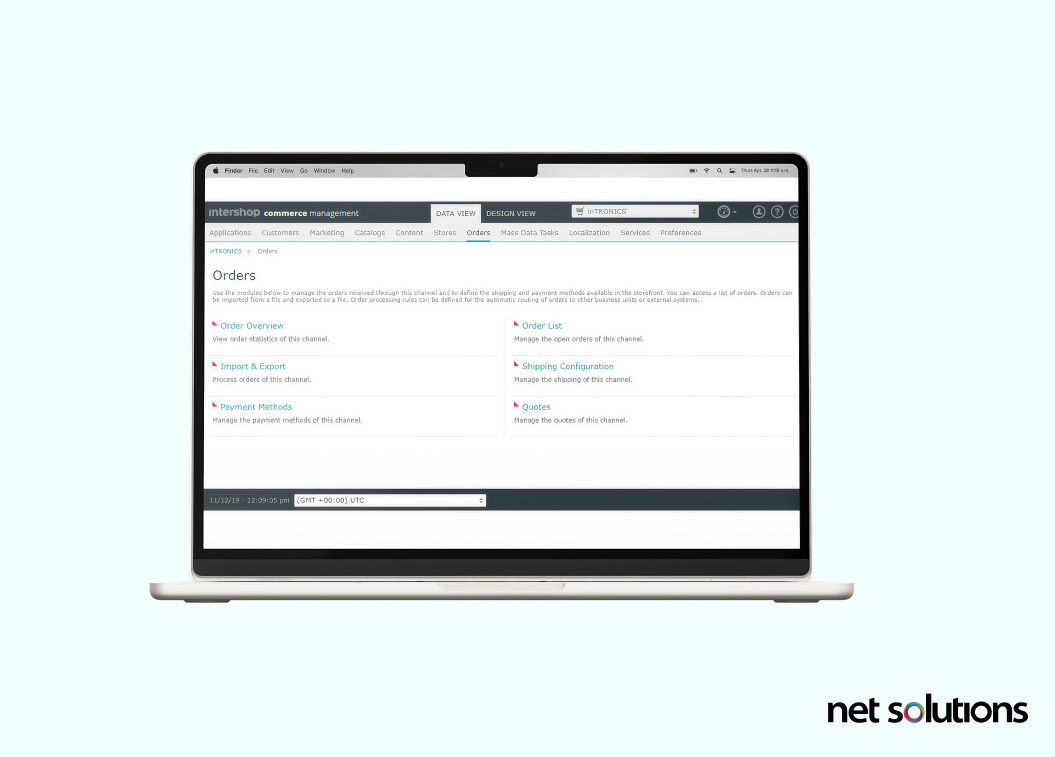
“Intershop Commerce is a trusted leader in the realm of enterprise-grade eCommerce solutions. I mostly like that it offers a robust suite of B2B features and comprehensive functionality that can be utilized straight out of the box. With a proven track record of supporting numerous large-scale online retailers, it efficiently manages vast product inventories and processes millions of orders. Additionally, its powerful business API ensures seamless integration with other systems.” – Roland E.
Top features:
- PWA Head: Progressive Web App head as an option to accelerate frontend development. An open-source project.
- Advanced B2B capabilities: self-service, custom approvals, quick orders, open catalog interface
- Automations for sales: Automate repetitive sales tasks and workflows
- AI Personalizations: New AI personalization will learn alongside your customers to keep improving over time
- Experience Management: manage websites, assets and campaigns from one system with page and component templates, drag and drop editing
Integrations:
The Intershop Integration Hub is designed for low-code fast integration with SAP, but third-party tool integrations are custom.
Pricing:
Intershop is available at three subscription levels, Essential, Advanced and Professional, each at custom price levels.
Target market:
Intershop is designed to power growing and complex B2B organizations.
Pros:
- Extensive number of APIs
- Advanced B2B features standard across all plans
- Tools to accelerate time to market in as little as 100 days
Cons:
- Not very intuitive to use
- Lower number of releases per year than other tools (less overall innovation)
- B2C tools are very basic
After looking at these headless commerce platforms, how do you know which is right for you?
How to Choose the Right Headless Commerce Platform for Your Business?
There are many factors that go into how you will decide which headless commerce platform is right for your business. Those factors will depend on the size of your organization, your specific business model, and your resources (time, skills, money) to devote to your eCommerce business. Knowing this, we suggest the following best practices:
- Collaborate with the tech team to set goals: Understand what business and technical users need from the eCommerce platform in a clear requirements document.
- Assess your digital maturity: Understand your current and desired state of digital maturity, understanding what your customers or buyers expect from their digital experience and how ready you are to deliver those capabilities in your (competitive) marketplace.
- Understand technical limitations: Ensure you have the technical knowledge in-house or through an experienced partner to work with the desired platform and to create and manage front-ends. Think long-term about how you will maintain the platform or improve it over time.
- Conduct thorough research: Identify platforms that meet your requirements, involve stakeholders in the short list and evaluation, read case studies, look at analyst reports.
- Engage with vendors: Since many vendors do not disclose prices and are constantly innovating, speak directly to vendors to better understand if the platform is right for you. Ask for the 6-month development plan and if there are any hidden fees or charges that may occur. Look at the history of performance metrics and available support.
- Look at the big picture for cost: Look beyond the scope of price tiers and include how expensive or inexpensive additional development is to customize the back-end, add integrations, create front-ends or swap services. If self-hosted, consider the added costs associated with that.
We hope this guidance will help you identify which headless commerce platform is right for you.
How Net Solutions Can Help
Headless eCommerce platforms are helping organizations become more agile and innovative, tapping into the latest capabilities and third-party tools and delivering personalized experiences at scale. A headless platform can help you future-proof your commerce needs, but as this guide has made clear, there is a wide span of platforms and capabilities, with maturity levels and prices that reflect those.
If you would like expert advice on which platform to choose or if you would like additional support in executing your headless commerce transition, our experienced eCommerce development team can help. Net Solutions has a strong history of delivering digital commerce experiences that exceed expectations.

